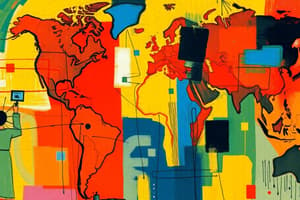Podcast
Questions and Answers
Cities consume ______ % of global energy.
Cities consume ______ % of global energy.
78
The major terror attacks of recent years have also targeted ______.
The major terror attacks of recent years have also targeted ______.
cities
The 9/11 attack targeted the ______ Trade Organization in New York.
The 9/11 attack targeted the ______ Trade Organization in New York.
World
The massive inequality brought about by economic ______ is very pronounced in cities.
The massive inequality brought about by economic ______ is very pronounced in cities.
It is common to find gleaming buildings alongside massive ______ in cities like Mumbai and Jakarta.
It is common to find gleaming buildings alongside massive ______ in cities like Mumbai and Jakarta.
[Blank] is the phenomenon of driving out the poor in favor of newer, wealthier residents.
[Blank] is the phenomenon of driving out the poor in favor of newer, wealthier residents.
Poor urban enclaves are occupied by ______ and immigrant families who are often denied opportunities at a better life.
Poor urban enclaves are occupied by ______ and immigrant families who are often denied opportunities at a better life.
As a city attracts more capital and richer residents, ______ prices go up and poor residents are forced to relocate.
As a city attracts more capital and richer residents, ______ prices go up and poor residents are forced to relocate.
In most of the world's global cities, the ______ class is also thinning out.
In most of the world's global cities, the ______ class is also thinning out.
Cities, especially those with global influence, are obvious targets for ______ due to their high populations and role as symbols of globalization.
Cities, especially those with global influence, are obvious targets for ______ due to their high populations and role as symbols of globalization.
Flashcards are hidden until you start studying
Study Notes
Globalization and Everyday Life
- Globalization affects various forms of cultural life, including daily practices.
- The role of global processes in everyday life will be explained by the end of this module.
The Global City
- Globalization is a spatial phenomenon because it occurs in physical spaces.
- Global cities are hubs of global finance and capitalism, and home to world's top stock exchanges.
Defining Global Cities
- Saskia Sassen popularized the term "global city" and identified three global cities: New York, London, and Tokyo.
- These cities are hubs of global finance and capitalism.
Indicators of Globality
- Centers of Economic Power:
- Market size
- Purchasing power of citizens
- Size of the middle class
- Potential for growth
- Examples of global cities:
- New York: largest stock market
- Tokyo: greatest number of corporate headquarters
- Shanghai: world's busiest container port
- Singapore: considered Asia's most competitive city
- Centers of Authority:
- Washington DC: seat of American state power
- Canberra: home to top politicians and bureaucrats
- Centers of Higher Learning and Culture:
- Influence of publishing industry
- World-famous universities (e.g. Harvard)
- Cultural hubs (e.g. Los Angeles, Copenhagen, Manchester)
Challenges of Global Cities
- Sites of great inequality and poverty
- Tremendous violence
- High per capita carbon footprint
- Sites of great energy consumption (78% of global energy)
- Targets for terrorist attacks
- Massive inequality brought about by economic globalization
- The Great Divide: gleaming buildings alongside massive shantytowns
- Gentrification: driving out the poor in favor of newer, wealthier residents
- Thinning out of the middle class
Studying That Suits You
Use AI to generate personalized quizzes and flashcards to suit your learning preferences.




